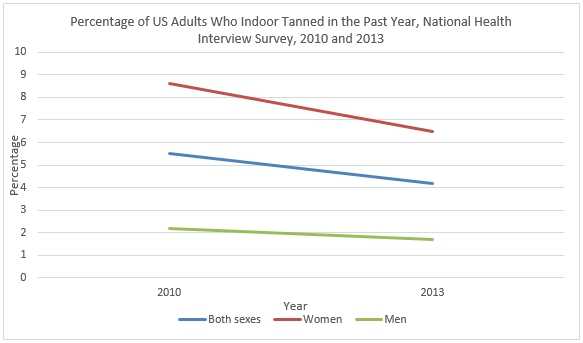Indoor Tanning Among Adults in the United States
Indoor tanning is declining in the United States, but nearly 10 million adults still tan each year.
Indoor tanning is decreasing in the United States, possibly because more people know about its dangers: it increases the risk of skin cancer, including deadly melanoma. Even with the decrease in use, millions of adults continue to indoor tan, increasing their risk for skin cancer and other health problems.
CDC monitors indoor tanning to track progress towards national goals for skin cancer prevention. CDC researchers compared responses to questions about indoor tanning on the National Health Interview Survey from 2010 and 2013.
Key Findings
- The percentage of adults who indoor tan went down from 5.5% in 2010 to 4.2% in 2013.
- The percentage of women who indoor tan went down from 8.6% in 2010 to 6.5% in 2013; 1.6 million fewer women indoor tanned in 2013 than in 2010.
- The percentage of men who tan indoors went down from 2.2% in 2010 to 1.7% in 2013; 400,000 fewer men indoor tanned in 2013 than in 2010.
- Indoor tanning went down among the groups most likely to tan—young women and non-Hispanic white women.
- Among indoor tanners—
- Young women indoor tan more often than women who are 40 years old or older.
- Men who are 40 years old or older indoor tan more often than younger men.
- Frequent (10 or more times a year) indoor tanning went down among women but not among men.
More research is needed to find ways to reduce indoor tanning among demographic groups other than young women. For example, men who are 40 years old or older and indoor tan tend to tan often, but are not the focus of any research.

Citation
Guy GP, Berkowitz Z, Holman DM, Hartman AM. Recent changes in the prevalence of and factors associated with frequency of indoor tanning among U.S. adults. JAMA Dermatology 2015.
- Page last reviewed: September 3, 2015
- Page last updated: September 3, 2015
- Content source:
- Maintained By:


 ShareCompartir
ShareCompartir